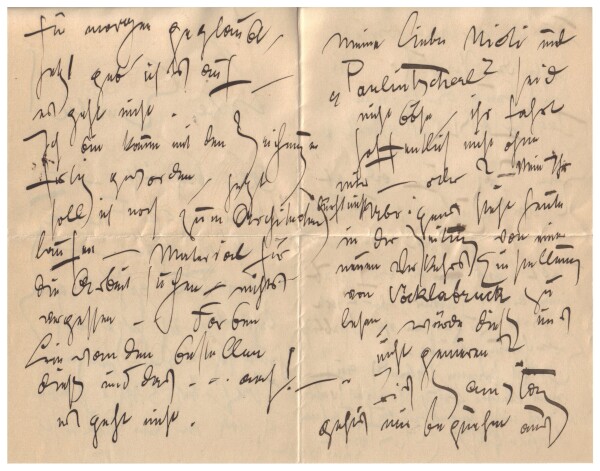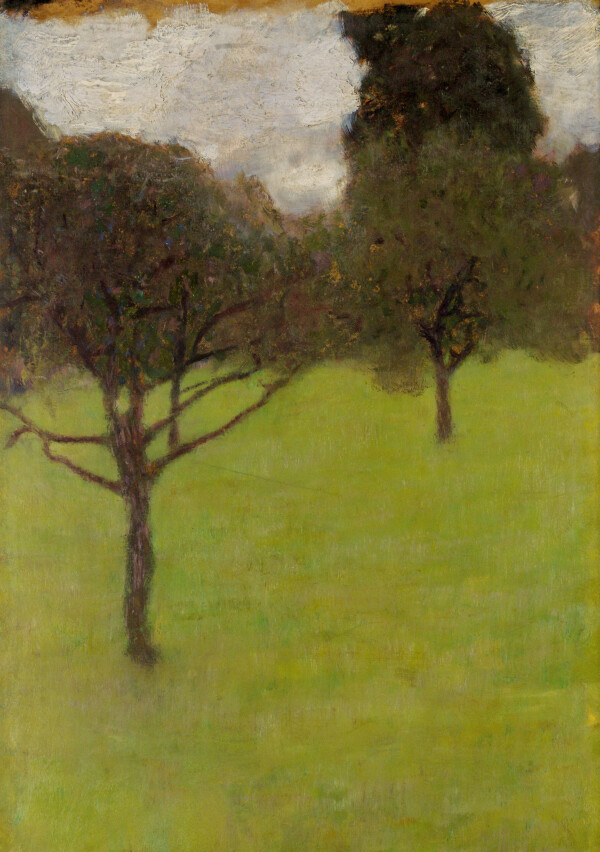Salzkammergut

Rudolf von Alt: The Dachstein in the Salzkammergut from the Vorderer Gosausee (peep-box sheet), 1840
© The ALBERTINA Museum, Vienna

Gustav Klimt: Curriculum vitae, written by Gustav Klimt himself, 12/21/1893, Akademie der bildenden Künste Wien, Universitätsarchiv
© Academy of Fine Arts Vienna, University Archive

Gustav Klimt: Letter with envelope from Gustav Klimt to Emilie Flöge in Vienna, presumably summer 1898, Belvedere, Wien, Dauerleihgabe aus Privatbesitz
© Belvedere, Vienna

Gustav Klimt during his summer stay in St. Agatha, presumably summer 1898, Klimt Foundation
© Klimt Foundation, Vienna

Gustav Klimt: Orchard, circa 1898, private collection
© Leopold Museum, Vienna

Gustav Klimt: Picture postcard from Gustav Klimt in Golling to Maria Zimmermann in Vienna, 08/20/1899, Klimt Foundation
© Klimt Foundation, Vienna

Gustav Klimt: A Morning by the Pond, 1899, Leopold Museum
© Leopold Museum, Vienna

Gustav Klimt: Picture postcard from Gustav Klimt in Golling to Maria Zimmermann in Vienna, 08/31/1899, Klimt Foundation
© Klimt Foundation, Vienna
The Salzkammergut region provided an ideal haven of relaxation and inspiration for Vienna’s high society and artistic elite during the hot summer months. Gustav Klimt also repeatedly visited this region from the late 1880s, with regular summer sojourns from 1898.
The Salzkammergut Region as a Summer Refuge
The social elite frequently split the year into two periods: While the time from autumn to spring was dominated by work and cultural entertainments, the summer months were reserved for retiring to the countryside. The Salzkammergut region was particularly popular with Vienna’s high society from the first quarter of the 19th century. This popularity was due on the one hand to the artistic exploration of this picturesque region by Ferdinand Georg Waldmüller, Friedrich Gauermann and Jakob Alt, and on the other hand to the regular sojourns of the Austrian Emperor and his family in Bad Ischl. The region’s salt deposits, initially of economic importance, were increasingly used for health purposes, as salt-water baths enjoyed a vogue. The fact that this area had been accessible since the second half of the 19th century thanks to the expanded Western Railway and Enns Valley line meant that it was also easily accessible by train.
Klimt’s First Visits
Klimt already sporadically visited the Salzkammergut region for summer sojourns during the late 1880s, for instance in the towns of St. Wolfgang and Gmunden. In his résumé written in December 1893, he mentioned “several short trips through the Salzkammergut region, Krakow, Trieste, Venice, Munich etc.” Franz Matsch also described in his memoirs how he and Klimt hiked “through the Salzkammergut region according to our whims and fancies, like two joyful journeymen.” Of course, the trips of those years had as yet little to do with the traditional summer sojourns of a renowned artist. About 10 years later, the region became Klimt’s preferred summer refuge.
1898: St. Agatha in the Salzkammergut Region
Together with the Flöge family, to whom he was related through his brother’s marriage, Gustav Klimt spent August and the first weeks of September of 1898 in St. Agatha near Bad Goisern, close to the Hallstätter See. Alma Schindler was also staying in the Salzkammergut region together with her family at the same time. In her memoirs she recalled how on a bicycle trip to Gosaumühle on 17 September she passed through St. Agatha, where “Klimt and his beloved sister-in-law” were staying. Rudolf von Alt – honorary president of the Vienna Secession – and the Austrian landscape painter Emil Jakob Schindler as well as the artists Carl Moll and Olga Wiesinger-Florian also enjoyed summer sojourns in this picturesque region. A letter from Klimt to Emilie Flöge hints that his departure from Vienna was delayed because of pressing business. The painter expressed his regret:
“My dear Midi and ‘Paulintscherl’ don’t be angry, I hope you won’t go without me – will you? – No, you mustn’t!”
A photo of Klimt, surrounded by his travel companions and presumably by locals, documents that he finally made it to St. Agatha. According to the tourist register of the municipality of Goisern, he lodged at the blacksmith’s shop next to the still existent “Agathawirt” inn.
The local landscape inspired Klimt to create his paintings Farmhouse with Roses (1897/98, privately owned), Orchard (around 1898, privately owned), After the Rain (Garden with Chickens in St. Agatha) (1898, Austrian Gallery Belvedere, Vienna) and presumably also Orchard in the Evening (1899, privately owned). The master painter presented the two latter works at the “VII. Ausstellung der Vereinigung bildender Künstler Österreichs Secession” [“7th Exhibition of the Association of Austrian Artists Secession”] in 1900. Ludwig Hevesi described them as “delicious atmospheric landscapes.”
1899: Golling “There is only one mailbox”
The following year, Klimt was staying in Golling near Hallein, on the westernmost border of the Salzkammergut region, together with Barbara Flöge and her three daughters Helene, Pauline and Emilie, presumably from early August to 3 or 4 September. Golling attracted artists and summer guests especially because of its impressive waterfall. “A tiny escapade” also took Klimt to Munich, as is revealed by a picture postcard written by the artist to Maria Zimmermann and dated 8 August. He wrote a longer letter to Zimmermann the following day, telling the mother of his second illegitimate son that there was only one mailbox in Golling. To avoid causing a stir with rumors of his heavily pregnant lover, who had stayed in Vienna, he asked Zimmermann to write to him only in case of an emergency. He described the scene vividly:
“[…] any letters that arrive are laid out at the inn, where I dine in company, these circumstances naturally entail a great deal of control, making unwelcome questions plausible, I have never kept my correspondence a secret during my stays in the country […] I have never received letters from females in the countryside, it would be conspicuous to act secretively, I must therefore be twice as cautious […].”
He also asked Maria Ucicka, the mother of his first illegitimate son Gustav Ucicky, also born in 1899, to refrain from sending him letters. Compared to Zimmermann, Ucicka received less correspondence from Klimt: He sent her two letters shortly before his departure, while Zimmermann was favored with three picture postcards and a letter during his stay in the country.
During these weeks of relaxation, Klimt created the works A Morning by the Pond (1899, Leopold Museum, Vienna) and Cows in the Stable (1899, Lentos Kunstmuseum, Linz). The motif of the former work was the Eglsee, a lake about 20 kilometers from Golling. The work holds a special position in Klimt’s oeuvre, because it is his first landscape executed in a square format. It was also presented at the “VII. Ausstellung der Vereinigung bildender Künstler Österreichs Secession.”
On a picture postcard written to Zimmermann shortly before his departure for Vienna, Klimt explained that the weather in Golling – as it would be on the Attersee in the following years – was not always favorable to plein-air painting and the observation of nature:
“Am facing unfavorable weather for the completion of my works.”
From 1900 to 1916, the picturesque Attersee and its surroundings became the preferred summer haven of relaxation and inspiration for Gustav Klimt and the Flöge family.
Literature and sources
- Stephan Koja (Hg.): Gustav Klimt. Landschaften, Ausst.-Kat., Upper Belvedere (Vienna), 23.10.2002–23.02.2003, Munich 2002.
- Stephan Koja: Jenes völlige Verschlungensein in der Schönheit des Scheins…, in: Stephan Koja (Hg.): Gustav Klimt. Landschaften, Ausst.-Kat., Upper Belvedere (Vienna), 23.10.2002–23.02.2003, Munich 2002, S. 31-47.
- Alfred Weidinger: Die Landschaften, in: Alfred Weidinger (Hg.): Gustav Klimt, Munich - Berlin - London - New York 2007, S. 140-173.
- Sandra Tretter: Gustav Klimts Naturvision im Atelier und auf Sommerfrische, in: Sandra Tretter, Peter Weinhäupl (Hg.): Gustav Klimt. Florale Welten, Vienna 2019, S. 27.
- Verena Perlhefter: Es ist so ein schöner Moment in der Landschaft. Zur Sommerfrische in Österreich, in: Stephan Koja (Hg.): Gustav Klimt. Landschaften, Ausst.-Kat., Upper Belvedere (Vienna), 23.10.2002–23.02.2003, Munich 2002, S. 17-29.
- Herbert Giese: Franz von Matsch – Leben und Werk. 1861–1942. Dissertation, Vienna 1976.
- Lebenslauf, eigenhändig verfasst von Gustav Klimt (12/21/1893). Beilage zu Verwaltungsakt Zl. 497-1893, .
- Brief mit Kuvert von Gustav Klimt an Emilie Flöge in Wien (vermutlich Sommer 1898). Lg1546.
- Goiserer Fremden-Liste, 27.07.1898, S. 4.
- Brief mit Kuvert von Gustav Klimt in Wien an Maria Ucicka in Wien (24.07.1899). S15/4.
- Brief von Gustav Klimt in Wien an Maria Ucicka in Wien (Ende Juli 1899). S15/5.
- Ansichtskarte von Gustav Klimt in München an Maria Zimmermann in Wien (08.08.1899). S64/5.
- Ansichtskarte von Barbara Flöge und Gustav Klimt in Golling an Hermann Flöge jun. in Wien, mitunterschrieben von Helene Klimt sen., Emilie und Pauline Flöge, LGM 31/23 (11.08.1899), .
- Brief von Gustav Klimt in Golling an Maria Zimmermann in Wien (09.08.1899). S63/8.
- Ansichtskarte von Gustav Klimt in Golling an Maria Zimmermann in Wien (20.08.1899). S64/6.
- Ansichtskarte von Gustav Klimt in Golling an Maria Zimmermann in Wien (31.08.1899). S64/8.
- Anthony Beaumont, Susanne Rode-Breymann (Hg.): Alma Mahler-Werfel. Tagebuch-Suiten. 1898–1902, 2. Auflage, Frankfurt am Main 2011, S. 120.

